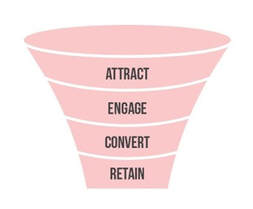|
The death care business and advertising have a tenuous relationship. Part of it is not merely a scarcity mindset, but a scarcity reality: when my ad dollar can’t grow the market and has questionable likelihood of growing market share, I have to wonder if there are better investments. And, especially in an environment where the words “inflation” and “recession” (let alone “post-COVID slowdown”) are inescapable, many firms are looking for places to save a buck or two. While fearfulness doesn’t make for good management, preparedness does. Business owners are (and should be) thinking about how to batten down the hatches should the need arise. Even if it all comes to nothing, it’s good to have a plan. In my firm’s quarter-century, our clients have frequently been faced with the need to trim their ad budgets during tough economic times. The solution ain’t what it used to be. RECONSIDERING THE FOUR P’S OF MARKETINGThere was a time when I coached clients to stay the course. For years I’ve told a story about a friend who owns a local cigar shop. In 2008, during the Great Recession, he invested heavily in his company, moving into a larger location, opening an affiliated lounge, and expanding his inventory. Looking back, he says that if he had taken a defensive stance, his business would have faltered instead of growing as it did. I’ve used that as an illustration of why it’s a good idea to maintain or even increase your marketing budget through recession. But here’s the rub: my friend didn’t invest in promotion. He invested in his place. Place is an often-neglected pillar of the four Ps of marketing, but it’s as much a part of marketing as the other three. Ad agencies tend to focus on promotion — paid advertising and its cousins — to the exclusion of all else. That’s like tying two arms and a leg behind your back, especially when you’re trying to squeeze every return you can out of limited marketing dollars. Consider this: would you rather get a thousand people to check out your business, only to discover that it’s run down and outdated, or have ten people engage with it and be instantly impressed by what they see? Advertising has its role, but it’s only one aspect of a well-rounded marketing plan. This is especially true these days. Place is a high-ROI investment, and in 2023 it goes well beyond the physical. It includes your digital footprint as well, and for most funeral homes that’s a strategy that is far underleveraged. Why? Because we tend to think of marketing as a funnel. Begin at the top, the thinking goes, and cast a wide net to a large number of people, hoping some fraction of them engage with you. Then work to convert some fraction of those people. Then do your best to keep some fraction of those people as repeat customers. Digital strategies that focus too heavily on AdWords and SEO are simply applying this old thinking to new tactics. But it’s hard to make that math work in our favor. REVERSING THE MARKETING FUNNEL Our lowest hanging fruit is the customer base we keep (by the way, this applies to staffing, too, which is important to note during a labor crisis). The more we focus on building our offerings around it, the stickier (and more successful) we’ll be. Thus, we should begin at the bottom of the funnel, focusing on retention before all else. Only then should we move up a level, to conversion. Is your physical space attractive and conducive to winning new customers? Is your website relevant and effective to those who are unfamiliar with you? Are your products and services priced correctly? These are questions more of strategy than spending (though the one should follow the other). Better to reach fewer people who will all become fans than to reach more people who will be disappointed. Assuming those two are in order, next up is engagement. This is where the digital-as-place strategy comes fully into play. Say you’re a retailer. People might come into your store ready to spend, or they might just be window shopping, but either way, they’re checking you out and trying to decide if what you offer is what they need. Their behavior in the digital universe is no different. It’s not a place to cut corners, nor is it a place to design around your own tastes, preferences, or ego. Everything you do to engage prospective customers, online and off, should be carefully calibrated to their interests. Imagine if a retailer managed its storefront the way the average business manages its digital outreach: “I don’t have time to think about it right now,” or “We tried banner advertising five years ago and it didn’t work,” or “Yeah, I don’t understand that stuff, but we hired Kayley to handle it for us. She’s a Millennial.” Here’s where you should also be wary of impressive-but-vague promises of Search Engine Optimization (SEO) vendors. I’ve had numerous clients tell me they have a vendor who handles SEO for them, but I have yet to hear any of them articulate what’s actually happening or what return they’re getting for their investment. SEO is only one piece of your digital space, alongside UX, Google My Business, content development, social media management, programmatic advertising, and more — in the same way that a physical building is comprised of plumbing and framing and roofing and electrical. Without a general contractor and a blueprint, the specialists won’t give you the space you’re hoping for. In the same way, every component of your digital presence must be coordinated around a unified objective, prospect profile, and brand identity. Finally, working our way up to the top of the funnel, there’s attraction. If you’re forced to cut advertising in the face of a recession, this is where to do it. The obvious caveat here is if advertising works, a brand that neglects it does so at its peril. But in a moment of austerity, if you have to cut something, it’s better to prioritize, and cut first the places you will feel it last. Still, that doesn’t mean you won’t feel it at all. Cuts to an advertising budget are not without consequence. If you are not investing in building awareness and preference for your brand, awareness and preference will decline. This is especially important to remember because the nature of these declines makes it easy to convince yourself they’re not happening. There’s usually a lag of at least one or two years, which is why you will run into people at a coffee shop who tell you they just saw an ad you haven’t run in six months. Eventually, however, the lag catches up with you, and your company will feel the impact. Still, that’s a very different thing from saying you can’t cut spending. Even though there are plenty of reasons not to, cutting your attraction budget might still be the right thing to do if your company is on the ropes. The most important thing during challenging economic times — at any time, for that matter — is to ensure that your brand’s house is in order. To reference the familiar parable, retention and conversion are “big rocks” that must go into the jar first. And they usually go hand in hand with your place, both digital and physical. Advertising is important, but it’s the sand that goes into the jar last — if you put it in first, you won’t have room for the other investments. Start at the bottom of the funnel and work your way up. making the cutDo you know your clients or customers? Do you know exactly what your brand represents to them? Are you executing with excellence? Are your internal dynamics healthy? If a casual observer visited with your executive team, would they believe that your leadership is aligned and confident? If the answer to any of those questions is “no,” or even “I’m not sure,” that’s the place to start (here’s a tool to help you quickly and efficiently find out). It’s tough to do surgery on yourself. Some of these decisions are best made with the help of professionals. But it’s even tougher to go under the knife of multiple surgeons at once. Marketing is an increasingly fragmented discipline, with dozens or even hundreds of specialists each representing their viewpoint of the world. That’s why having your own viewpoint — and an integrated marketing strategy that delivers on it — is vital. Without it, you will be continually tugged here and there and nothing will have a chance to work. Rather than a blanket cutting strategy (10% reductions on every line item), it’s vital to make the right cuts, in the right places, so as to minimize the long-term consequences. Handled properly, the effects of a temporary reduction in your advertising budget can be offset by improvements down the funnel. By prioritizing and aligning your efforts, it’s possible to weather adverse conditions and emerge stronger than ever.
Comments are closed.
|
The Cremation Logs Blog
Cremation experts share the latest news, trends, and creative advice for industry professionals. Register or log in to subscribe and stay engaged with all things cremation. Categories
All
Archives
July 2024
|
|
